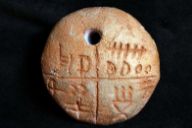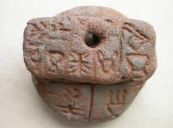Holes
Before looking into the issues of text and depiction, let us look at some material aspects of the tablets. As you can see here, two of the three tablets are pierced with a small hole, the round one and one of the rectangular ones. When we see holes in objects such as these, we always have to look twice before we can judge whether these holes were made intentionally, or whether they are the result of hungry worms.
In this case, the holes appear to be man-made. They look very neat and do not intervene with the carvings. Their exact function is not known, but possibly these holes were used to attach the tablets to other objects or cloths by means of a string (see, for example, the clay weights that were pierced for this reason). Although much is uncertain, big narratives have been postulated. For example, in their 2016 chapter ‘Tărtăria Tablets: The Latest Evidence in an Archaeological Thriller’ Lazarovici and Merlini put forward the following critical fabulation:
[r]egarding the Tărtăria tablet it is noteworthy to consider the possibility of overlapping the two tablets which both bear a round hole and are divided into cells. Indeed,the hole on the rectangular tablet fits perfectly the hole on the circular one and the former tablet perfectly covers the upper register of the latter with their cells in perfect alignment. This could mean that the two tablets were worn as necklaces, one over the other, as pendants and the resulting compound between the rectangular and circular tablets may have created a relationship of overt (seen) and esoteric (hidden) signs (i.e.,the signs on the upper register of the circular tablet would have been covered). The fact that the two punctured tablets could have been utilized as superimposed exoteric and esoteric amulets is indicative of the magical associations of the script.cf, p.132
The above theory may sound appealing, but it cannot be proven. It also does not explain what the function of the third tablet, which is not perforated, was. Since the available evidence is so limited, any claim about the function of these tablets is inevitably speculative.


